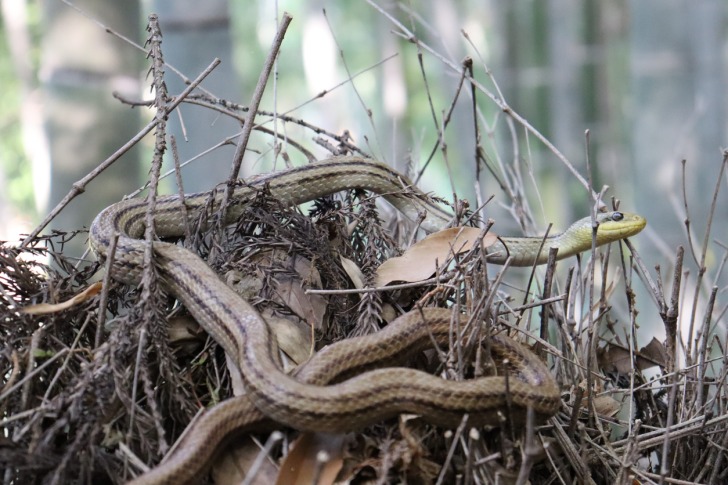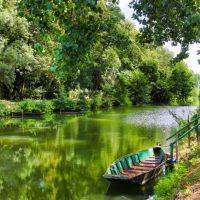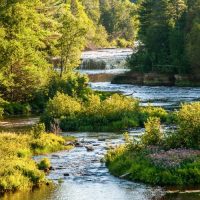Scotland is known for its remarkable castles, the Loch Ness Monster and Haggis.
However, one thing Scotland isn’t known for is its snakes.
While the country has a snake population, it’s much less than others.
Like other European countries, the temperatures get too cold for snakes to thrive.
If the environment is too cold, then the snakes will freeze before they even get a chance to mature.
Hence, Scotland doesn’t have a big snake population.
However, that doesn’t mean that there are zero snakes.
There is one venomous species native to Scotland.
Below, we’ll introduce you to snakes in Scotland and where you can find them.

Contents
So… Are There Snakes in Scotland?
The answer to if there are snakes in Scotland is yes and no.
While Scotland does have a snake population, it’s only because of one species.
Other than that, the country is basically barren in terms of snakes.
There is a scientific reason behind why there aren’t any snakes in Scotland.
Nearly more than 10,000 years ago, an ice age kept the island too frigid for snakes.
Due to this, the snakes migrated towards the western and northern parts of Europe.
After the Ice Age, snakes started returning to certain areas with warmer climates.
This included England, Wales, and Scotland.
In addition to that, snakes are ectothermic creatures that can’t produce heat on their own.
Due to this, they have to rely on a good climate to warm their bodies.
Scotland has varying weather that can get too cold for snakes to survive in winter.
So, they tend to avoid living in Scotland because they can’t warm their bodies.
Snake Species in Scotland
The Adder snake is the only species that can survive in Scotland’s cold climate.
It’s a species that is native to the country and is venomous.
Adders are only found in specific areas of Scotland, so your chances of running into one are low.
However, they can be found in heathland, moorlands, and woodland.
The reason that the Adder snake can survive in Scotland is due to hibernation.
Unlike other snake species, the Adder hibernates in the fall when the temperature drops.
From October until March, they are burrowed in a shelter and are asleep.
Once the end of March comes, the Adder wakes up from hibernation and goes about its life.
While not indigenous to Scotland, a few other species of snakes can be found in the country.
The smooth snake is found in southwest England and is rarely seen in Scotland.
However, there have been a few sightings.
Grass snakes can be found around the border of Scotland and are often spotted due to their unique greenish-grey color.
However, the chances of running into one is very low.
The only other animal mistaken as a snake is a slow worm, a legless lizard.

Is it Safe to Go on a Trek in Scotland?
Scotland is generally safe to trek in, and there isn’t much risk regarding animal danger.
Instead, Scotland has a different problem you should worry about when hiking.
The weather and climate can change very rapidly.
The weather can turn in an instant and make visibility difficult.
Fog is very common, and cloudy weather can make visibility challenging if only the naked eye is used.
The fog can roll in within a few minutes, making it dangerous to trek on a mountainous path.
Some hikers have even gotten lost in the fog, making it dangerous if you don’t know what to do.
Luckily, you can take extra precautions to avoid this scenario.
Taking extra food and water can help you in case the weather changes.
In addition, adding warm clothes and even a flashlight can be a lifesaver move.
Scotland gets pitch black at night, so being prepared to spend a night in the wilderness is key.
Interesting Snake Facts in Scotland
Since the Adder is the only type of snake you’ll run into in Scotland, we can only say a few facts.
The first is that each adder has a unique head marker.
On top of the adder’s head is either a “V” or “X” shape, which are very distinguishable.
Also, adders don’t lay eggs like most other snake species.
Instead, the adder will push out live snake babies, up to 20 at a time!
The baby snakes are similar to adults, just as small as an earthworm.
Lastly, adders have a distinctive, unblinking stare.
Historically, there is a rumor that adders use to stare into people’s eyes to hypnotize them.
However, that’s not true.
Today, we understand that adders have transparent eyelids, making them look like they aren’t blinking.
3 Safety Tips for Exploring Nature in Scotland
Scotland is an interesting place to trek, as the mountainous regions and lowlands make it different from other places.
However, you’ll want to stay safe on your travels.
You’ll need to pay attention to aspects other than snakes to do this.
Below, we’ll provide three tips that we find useful when trekking Scotland.
1. Prepare For Longer Treks
Treks in Scotland can vary depending on the climate and weather.
Since fog is common, it can easily get lost when the weather shifts.
Some people planned a two- to three-hour hike but ended up in the same area for nearly six to eight hours.
This wasn’t due to poor planning on their part but because the weather shifts so rapidly.
The best thing to do is add at least a few hours to your planned trip.
Be sure to go early if you rely on buses or taxis to get to places.
In addition, make sure you’ve told someone where you are.
That way, if things get dicey, someone knows your last location.
2. Keep Yourself Warm
Scotland is pretty cold sometimes, and you’ll need to keep yourself warm when the weather changes.
Using thermal coats and pants can help keep you warm.
You’ll also want to invest in gloves, hats, and warm boots.
Bringing hand warmers can also help you keep warm if you get stuck outdoors.
Waterproof clothing is also recommended.
Scotland sees a lot of rain, which can stick to your clothing and cause your body temperature to drop.
Get clothing that not only has thermal heating but also that’s waterproof.
3. Don’t Rely on Weather Reports
Weather can be very tricky to determine in areas for hiking.
As stated multiple times, the weather can change within a few minutes for better or worse.
Even if you plan to go on a sunny day, you could be covered in rain and fog.
Be prepared for these types of changes.
Summary
Scotland doesn’t have snakes other than the adder.
It doesn’t have that many reptiles either.
So, if you plan to discover this beautiful country, you’ll be safe traveling.
The chances of running into an adder are low, but you should still be aware of your surroundings.
That said, we hope we’ve helped you learn more about snakes and Scotland!
Scotland Safety Overview
READ THE FULL REPORT: Scotland Safety Review
Safety Index:
- OVERALL RISK: LOW
- TRANSPORT & TAXIS RISK: LOW
- PICKPOCKETS RISK: LOW
- NATURAL DISASTERS RISK: MEDIUM
- MUGGING RISK: LOW
- TERRORISM RISK: HIGH
- SCAMS RISK: LOW
- WOMEN TRAVELERS RISK: LOW
Frequently Asked Questions
What do you do if you’re bit by an adder?
Keep the bite low if you’ve been bitten by an adder.
You should sit with your leg facing downhill and loosen any clothes near the bite.
Adders do a “dry bite,” which won’t always inject venom into your body.
However, you can still experience symptoms of having a bite.
The best thing to do is to get to a hospital or contact emergency services.
How common are snakes in Scotland?
The only snake widespread in Scotland is the adder.
Other than that, there aren’t any other snakes in the country.
How poisonous are Scottish adders?
The adder doesn’t have lethal poison.
It’s of little danger to humans.
However, the bite can be very painful if not treated.











